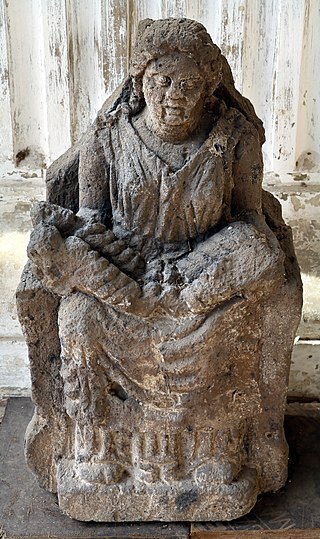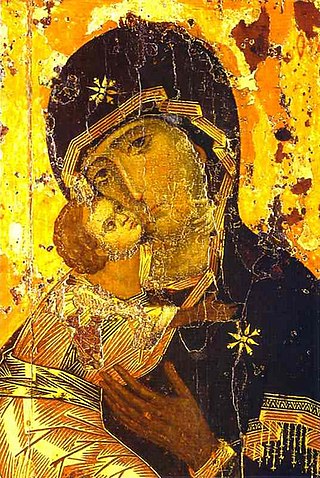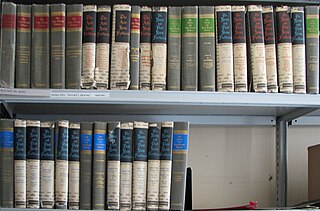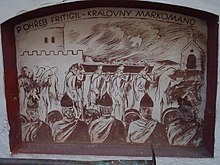
Ambrose of Milan, venerated as Saint Ambrose, was a theologian and statesman who served as Bishop of Milan from 374 to 397. He expressed himself prominently as a public figure, fiercely promoting Roman Christianity against Arianism and paganism. He left a substantial collection of writings, of which the best known include the ethical commentary De officiis ministrorum (377–391), and the exegetical Exameron (386–390). His preachings, his actions and his literary works, in addition to his innovative musical hymnography, made him one of the most influential ecclesiastical figures of the 4th century.

Agnes of Rome is a virgin martyr, venerated as a saint in the Catholic Church, Oriental Orthodox Church and the Eastern Orthodox Church, as well as the Anglican Communion and Lutheran Churches. She is one of several virgin martyrs commemorated by name in the Canon of the Mass, and one of many Christians martyred during the reign of the Roman emperor Diocletian.
The 390s decade ran from January 1, 390 to December 31, 399

Mater Matuta was an indigenous Latin goddess, whom the Romans eventually made equivalent to the dawn goddess Aurora and the Greek goddess Eos. She was the goddess of female maturation and later also of the dawn. Her cult is attested to in several places in Latium; her most famous temple was located at Satricum.

Doctor of the Church, also referred to as Doctor of the Universal Church, is a title given by the Catholic Church to saints recognized as having made a significant contribution to theology or doctrine through their research, study, or writing.

The Ambrosian Rite is a Latin liturgical rite of the Catholic Church. The rite is named after Saint Ambrose, a bishop of Milan in the fourth century. It is used by around five million Catholics in the greater part of the Archdiocese of Milan, in some parishes of the Diocese of Como, Bergamo, Novara, Lodi, and in the Diocese of Lugano, Canton of Ticino, Switzerland.

The Notitia dignitatum et administrationum omnium tam civilium quam militarium is a document of the Late Roman Empire that details the administrative organization of the Western and the Eastern Roman Empire. It is unique as one of very few surviving documents of Roman government, and describes several thousand offices from the imperial court to provincial governments, diplomatic missions, and army units. It is usually considered to be accurate for the Western Roman Empire in the 420s AD and for the Eastern or Byzantine Empire in the 390s AD. However, the text itself is not dated, and omissions complicate ascertaining its date from its content.

The perpetual virginity of Mary is a Christian doctrine that Mary, the mother of Jesus, was a virgin "before, during and after" the birth of Christ. In Western Christianity, the Catholic Church adheres to the doctrine, as do some Lutherans, Anglicans, Reformed, and other Protestants. The Oriental Orthodox Churches also adhere to this doctrine as part of their ongoing tradition, and Eastern Orthodox churches recognize Mary as Aeiparthenos, meaning "ever-virgin". It is one of the four Marian dogmas of the Catholic Church. Most modern nonconformist Protestants reject the doctrine.

Scythia Minor or Lesser Scythia was a Roman province in late antiquity, corresponding to the lands between the Danube and the Black Sea, today's Dobruja divided between Romania and Bulgaria. It was detached from Moesia Inferior by the Emperor Diocletian to form a separate province sometime between 286 and 293 AD. The capital of province was Tomis. The province ceased to exist around 679–681, when the region was overrun by the Bulgars, which the Emperor Constantine IV was forced to recognize in 681.

Vicarius is a Latin word, meaning substitute or deputy. It is the root of the English word "vicar".

Catholic Mariology is Mariology in Catholic theology. According to the Immaculate Conception taught by the Catholic Church, she was conceived and born without sin, hence Mary is seen as having a singular dignity above the saints, receiving a higher level of veneration than all angelic spirits and blessed souls in heaven. Catholic Mariology thus studies not only her life but also the veneration of her in daily life, prayer, hymns, art, music, and architecture in modern and ancient Christianity throughout the ages.

Resafa, sometimes spelled Rusafa, and known in the Byzantine era as Sergiopolis and briefly as Anastasiopolis, was a city located in the Roman province of Euphratensis, in modern-day Syria. It is an archaeological site situated southwest of the city of Raqqa and the Euphrates.

Legio II Armeniaca was a legion of the late Roman Empire. This legion may have been garrisoned in the Roman province of Armenia, but later, together with its twin, I Armeniaca, it was moved into the field army as a pseudocomitatensis legion. The legion is reported to have built a camp in Satala. According to Ammianus Marcellinus, in 360 AD. II Armeniaca was stationed in Bezabde with II Flavia Virtutis and II Parthica. When Shapur II besieged and conquered the city, killing many of the inhabitants. The II Armeniaca however, survived, since it is cited in the Notitia Dignitatum as being under the command of the Dux Mesopotamiae.

Patristics or patrology is the study of the early Christian writers who are designated Church Fathers. The names derive from the combined forms of Latin pater and Greek πᾰτήρ (father). The period of the Church Fathers, commonly called the Patristic era, is generally considered to run from the end of New Testament times or end of the Apostolic Age to either AD 451 or to the Second Council of Nicaea in 787.

The Valentinian dynasty was a ruling house of five generations of dynasts, including five Roman emperors during late antiquity, lasting nearly a hundred years from the mid fourth to the mid fifth century. They succeeded the Constantinian dynasty and reigned over the Roman Empire from 364 to 392 and from 425 to 455, with an interregnum (392–423), during which the Theodosian dynasty ruled and eventually succeeded them. The Theodosians, who intermarried into the Valentinian house, ruled concurrently in the east after 379.

Jovinianism refers to an anti-ascetic movement that has its origins in the 4th-century theologian Jovinian, who criticized the monastic movement and argued for the equality of marriage and celibacy. Jovinianism was criticized by Saint Augustine and Jerome.

Balis, also known as Barbalissos and Barbalissus (Latin), was an ancient and medieval fortress on the Euphrates River near the ruins of the still more ancient Emar. It is particularly known for the 253 Battle of Barbalissos, where the Roman army was defeated by Sassanid Persia. The fortress town's own ruins are located at the modern Qala'at Balis in the Aleppo Governorate of northern Syria.
Mother of the Church is a title given to Mary in the Catholic Church, as officially declared by Pope Paul VI in 1964. The title first appeared in the 4th century writings of Saint Ambrose of Milan, as rediscovered by Hugo Rahner. It was also used by Pope Benedict XIV in 1748 and then by Pope Leo XIII in 1885. Pope John Paul II placed it in the Catechism of the Catholic Church and Pope Francis inserted a feast by this title into the Roman Calendar.

The Notitia Urbis Constantinopolitanae is an ancient "regionary", i.e., a list of monuments, public buildings and civil officials in Constantinople during the mid-5th century, during the reign of the emperor Theodosius II. The text lists the fourteen regions in which Constantinople was divided, along with the major public buildings such as fora, theatres, churches, palaces, baths and cisterns. It also lists the number of "houses" (domus), although there is uncertainty over the exact meaning of the term. Finally, the list includes the civil officials of each region, including the curators, the heads of the associations (collegia) and the heads of neighbourhoods (vicomagistri).

The Brescia Casket, also called the lipsanotheca of Brescia or reliquary of Brescia, is an ivory box, perhaps a reliquary, from the late 4th century, which is now in the Museo di Santa Giulia at San Salvatore in Brescia, Italy. It is a virtually unique survival of a complete Early Christian ivory box in generally good condition. The 36 subjects depicted on the box represent a wide range of the images found in the evolving Christian art of the period, and their identification has generated a great deal of art-historical discussion, though the high quality of the carving has never been in question. According to one scholar: "despite an abundance of resourceful and often astute exegesis, its date, use, provenance, and meaning remain among the most formidable and enduring enigmas in the study of early Christian art."


















